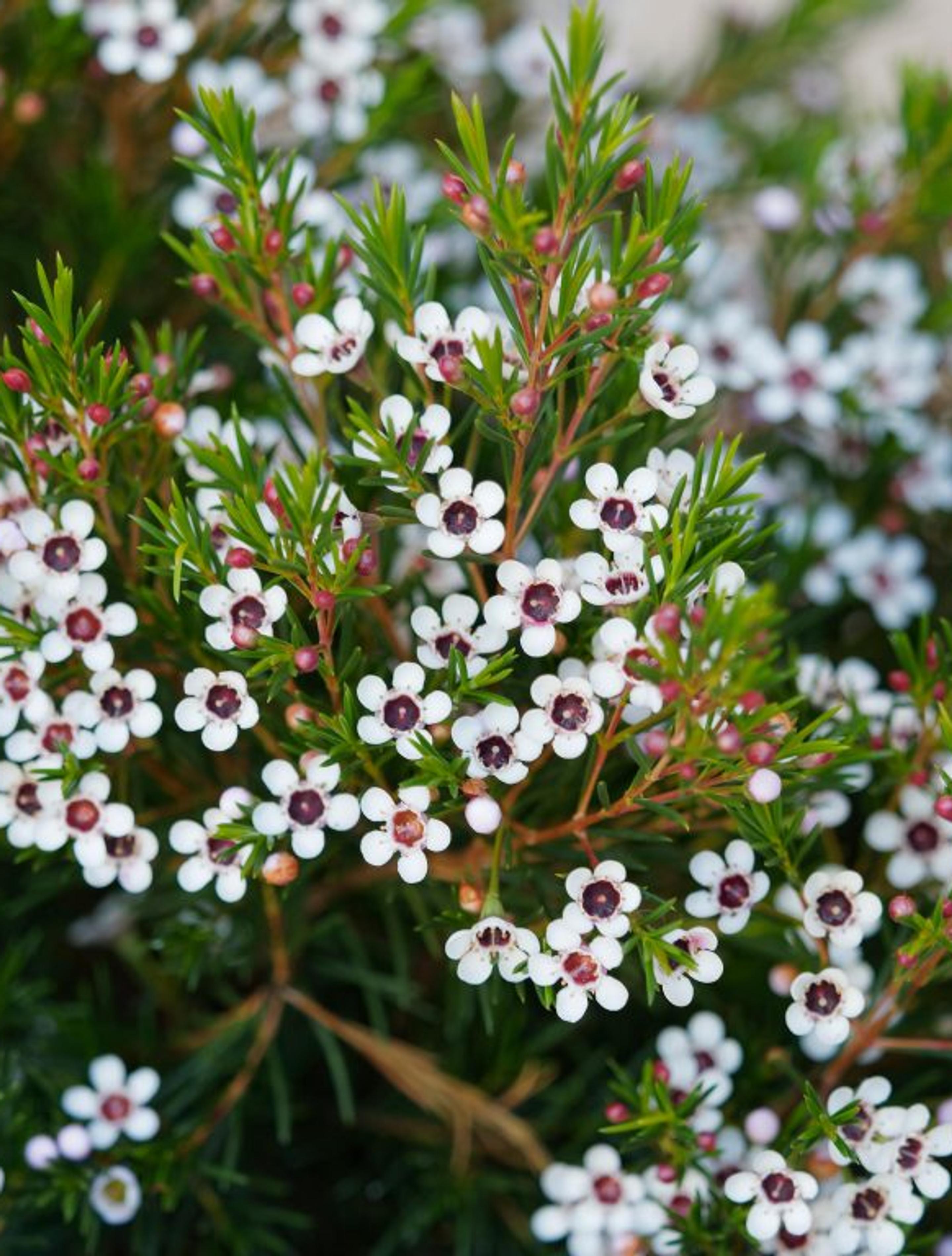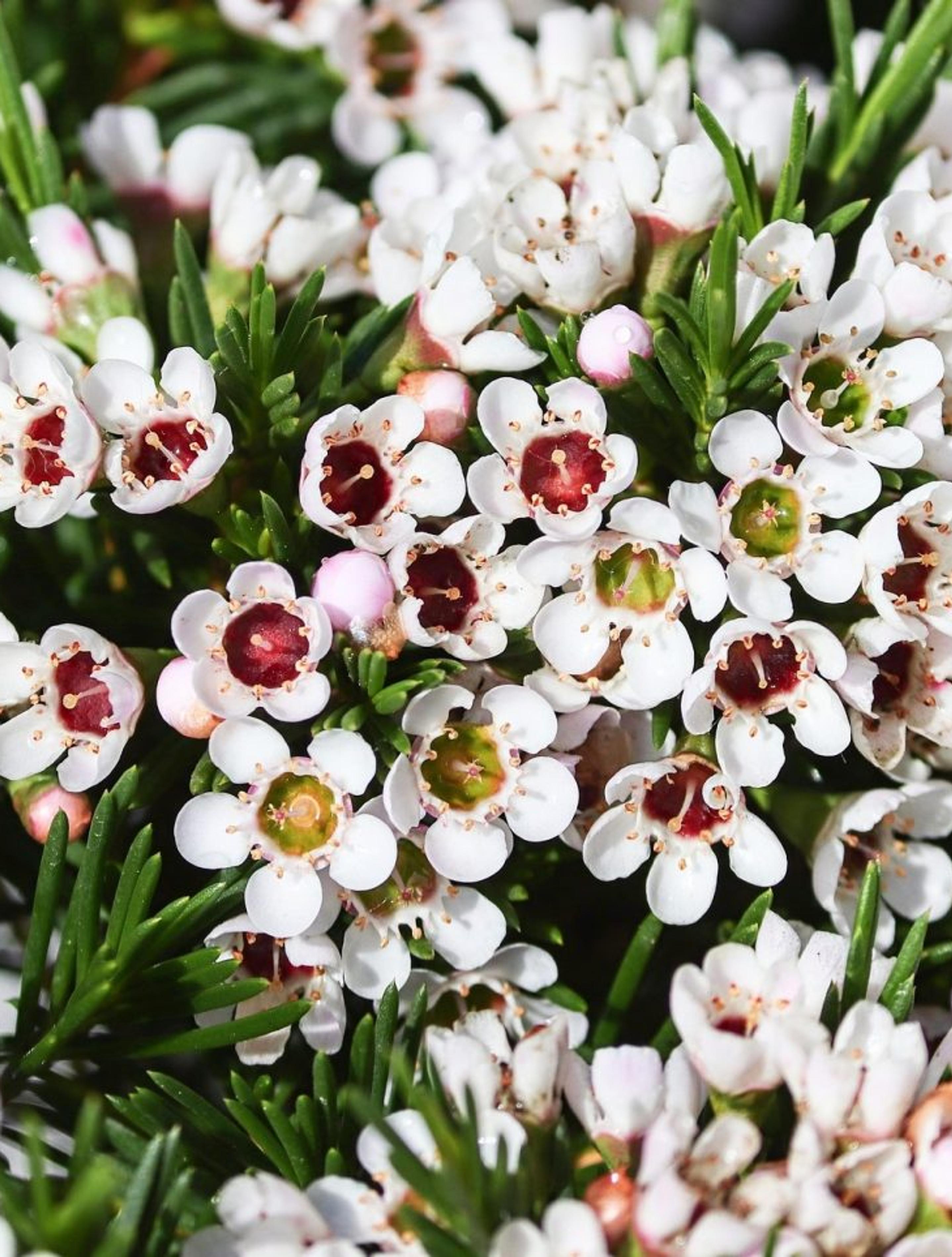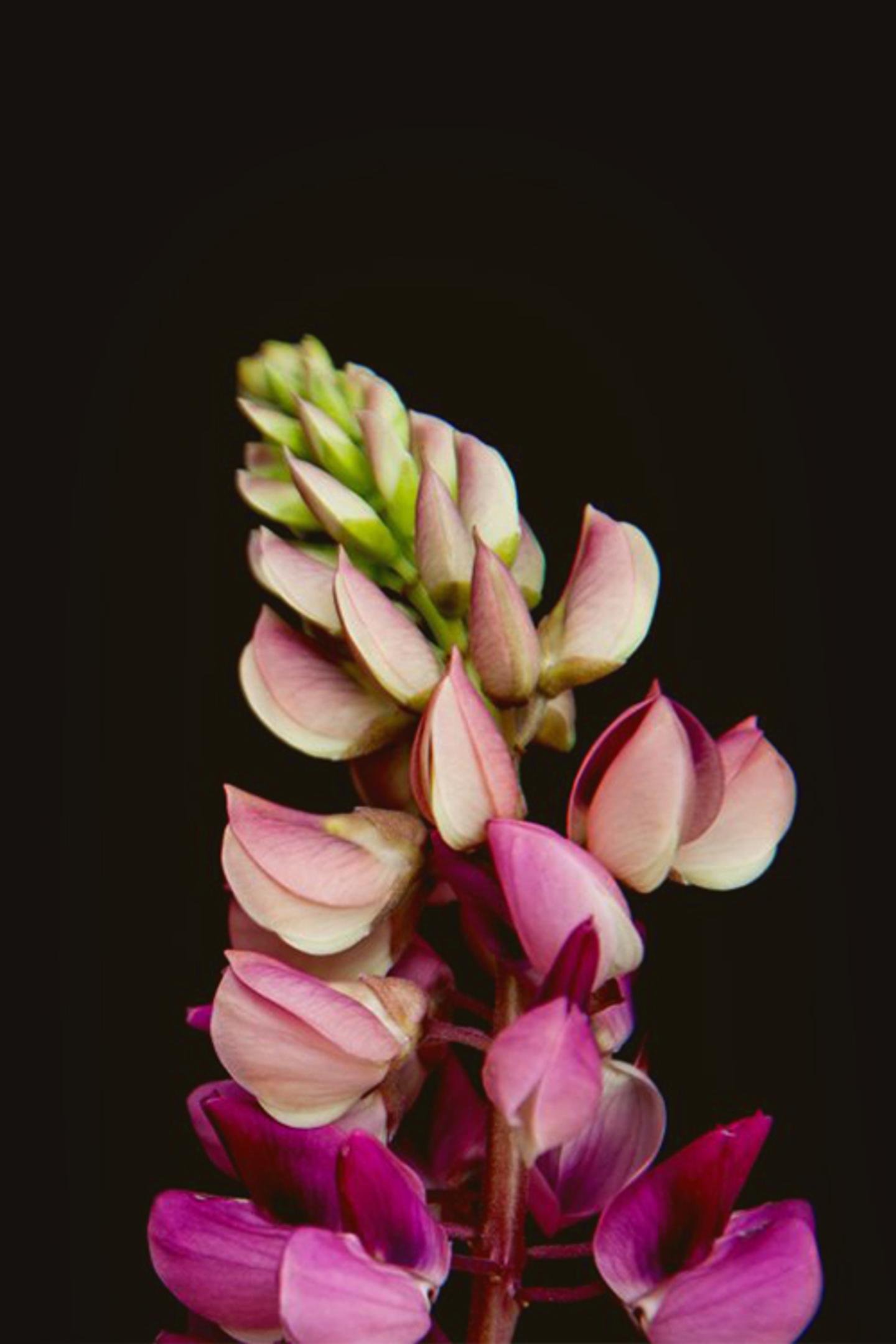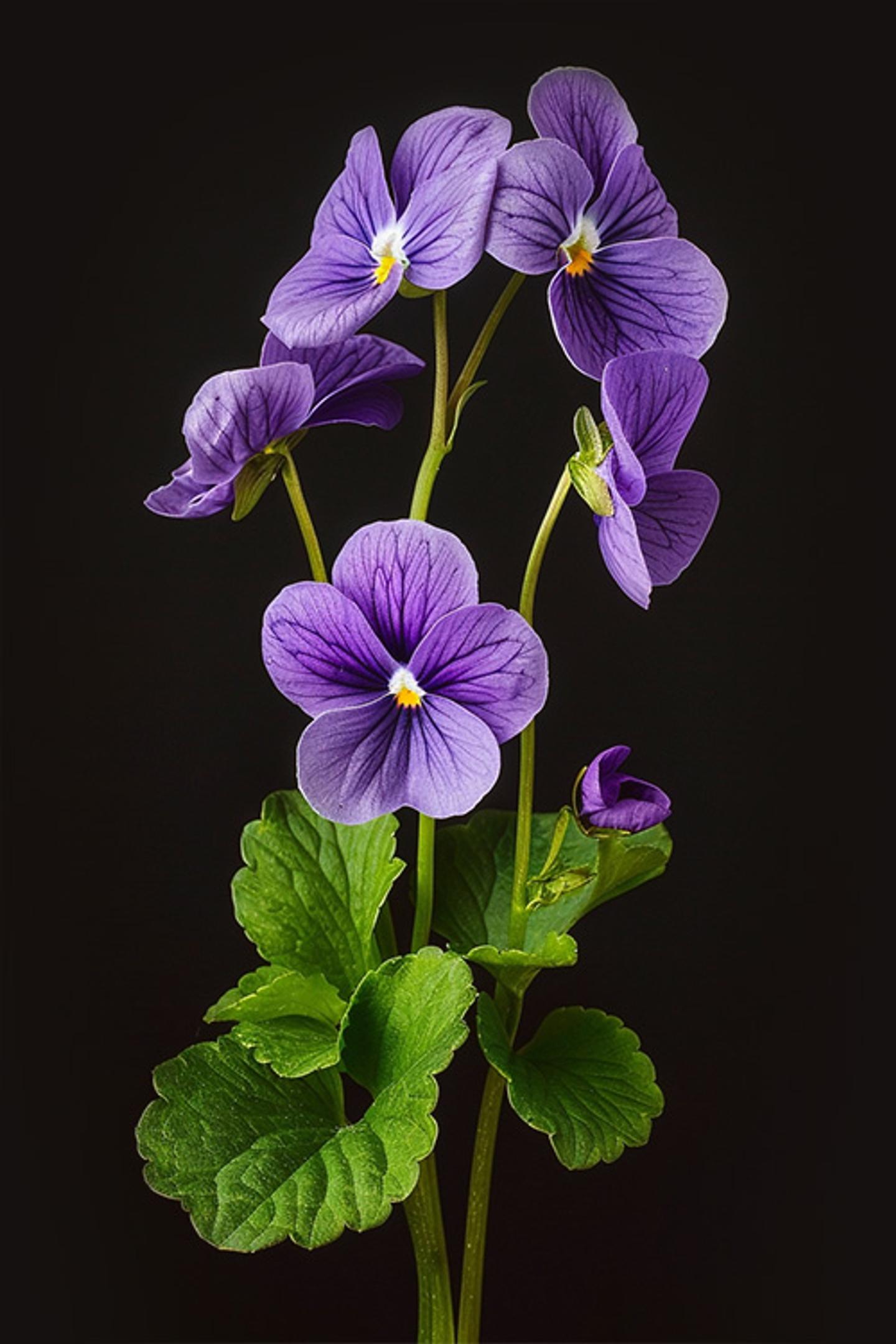Flower Meanings
Waxflower


The Meaning of Waxflower
The most popular variety of this lovely little shrub is Chamelaucium Uncinatum or Geraldton Wax. Their blooms are similar to those found on tea trees, and their dainty appearance and sweet scent make a more than perfect addition to your home garden, kitchen table, or wedding bouquet. [1] The colors of the petals can range anywhere from white to deep plumb or purple and most commonly bloom in the summer and autumn months. [2]
The waxy umbels of the waxflower, yes, they are actually quite waxy, hold deep, heart-felt symbolism. Not only are they known to spread joy and happiness, simply based off of their looks alone, but their extended vase-life is said to represent a long and happy marriage, particularly in Australia, where the blooms originate. [3]
Since we’re talking about love, waxflower also symbolizes deep, lasting love, possessing the strength to endure any length of time, number of trials, or unwavering difficulties that life may throw its way.
Our waxy friends have also come to represent wealth and riches over time, not just in monetary terms, but also in terms of quality of life and and love, both in others and within the self, lining up directly with its naturally robust and sturdy nature. [4]
We know you’ve heard of the luck of Irish, but we bet you’ve never heard of the luck of the Australian! Good luck, best wishes, and long-lasting success, are also represented in waxflowers’ colorful petals, making it the perfect filler for those graduation flowers you were planning on giving!
Its botanical name, Chamelaucium, is thought to stem from the Greek words white dwarf (Leucos and Chamai, respectively) which refers to the plants’ small, traditionally white-colored petals. Uncinatum refers to the hooked shaped leaves of this particular variety. [2]
Don’t be fooled by their small size! There’s no doubt these waxy blooms will draw you in, hook, line, and sinker!

What Does Waxflower Smell Like?
Waxflower is well known for it’s light citrusy scent. [13]

When is Waxflower in Season?
Waxflower blooms in the flowering dead season of late winter to early spring. [14]

"Waxflower – your beauty inspires thought alone."
M.J.C. Cronin
The History of Waxflower
It all began on a dark and stormy night near the coast of Western Australia, 1819, where we have Rene Louiche Desfontaines, a famous French botanist, to thank for the discovery of our beloved waxflower. [3]
Upon its discovery, this waxy wildflower was originally named Geraldton Wax after the small town in which it was discovered, Geraldton. [12] The town of Geraldton lies along Champion Bay, across Geelvink Channel from the Houtman Abrolhos Islands, the perfect temperament for our lovely little waxflowers.
The city originated as a military post for the nearby Murchinson goldfield and was declared a town in 1871. During World War II, the military post actually served as an Allied amphibious airbase.
Gerladton is also home to massive quantities of barley, oats, fruits, sheep, mineral sands, and gold. This beautiful coastal town also exports many superphosphate plants, and rock lobsters. [6]
But enough of that, let’s get back to the man of hour! Quite the man of science, after attending the college at Rennes, Desfontaines traveled to Paris to study medicine where he met Louis-Guillaume Le Monnier, a professor of botany in what was then known as Jardin du Roi. In 1783 our man Desfontaines was elected a member of the Academy of Sciences and set off on a botanical expedition to North Africa that same year. He went on to succeed Le Monnier as a professor of botany. [5]
A man of taste and a scholar!
Bringing ourselves back to the present, today, waxflower is often found near the coastline, growing on sand or outcrops of granite. Not really a place where you’d imagine a flower to grow, huh?
There have been many hybrid species of waxflower identified so far:
- Album: white flowers
- Bundara Excelsior: large pink flowers
- Purple Pride: Reddish-purple flowers
- University: Red stems and rose-purple flowers that transform into a full purple [7]
just to name a few!
DID YOU KNOW - Waxflower Fun Fact
Waxflower is important economically for many edible fruits including guava, rose apple, spices such as allspice and cloves, and timber (eucalyptus)!

How to Grow Waxflower
This lovely evergreen shrub with its delicate branches and fine texture, commonly blooms in winter to early spring, and is most definitely of the “plant it and forget it” varieties. (Woo-hoo!). It does, however, require good drainage and a sunny location to achieve it’s best growth. They don’t require too much water and can actually grow quite well with varying amounts of watering!
Pro Tip: Prune your waxflower in the winter to expose its branching and to remove dead wood as necessary. [8]
Now back to their most important trait, their low maintenance tendencies! Kidding! Well, only slightly. This bloom truly is the lazy gardener’s dream, and cannot be beaten for its reliable, consistent blossoms, ease of care, and tolerant nature.
These perennials will produce non-stop blooms, making them perfect for cut flower arrangements and can last up to 3 weeks after being cut!
They are also incredibly fast-growing and create a thick, colorful shrubbery (4-6 ft in height and width)!
Because of their intense height, they do tend to fall over as they grow; therefore, support is often needed to help these dense shrubs to remain upright.
Its flowers are usually a deep purple to red, with bright, shiny, berry-like buds arranged in open sprays along the ends of its stems. Its foliage deep forest green and narrow, almost needle-like. Attractive red tinted stems ensure those needly, deep green leaves pop!
In terms of growing conditions, organic soil of a depth of 8-10 inches will ensure quick establishment, growth, and consistent draining. You can also add sand or another gritty material to enhance its percolation (the process of water slowly passing through).
Young waxflower plants may need irrigation as they establish themselves, but older, more mature plants can withstand quite long periods of drought.
Your waxflower will remain in prime condition if its conditions mimic that of Australia as closely as possible: sandy soil and sparse moisture (except during the rainy season). They may require a little extra organic mulch if their soil is low in nutrients.
Beware: Commercial fertilizer can do more harm than good to these waxy gems. [9]
DID YOU KNOW - Waxflower Fun Fact
Waxflower produces large quantities of oil from its glands and its leaves give off a fresh, clean lemony scent when crushed! Yum!

How to Care for Waxflower
While waxflower does not require too much care, a light pruning here and there goes quite a long way. Whether you are trimming your waxflower stems from the garden or maintaining blooms bought from your local flower shop, be sure you have a pair of secateurs for cutting due to waxflower’s thick stems and rough, woody exterior. [2]
Pro Tip: Make sure your secateurs are as sharp as possible to avoid crushing the stem and limited water intake!
The first thing you will want to do is prepare a clean container and fill it with warm water and a flower-preservative if you have it!
Next, remove all foliage on the stem that would be below the waterline of your container.
Now it’s time to cut (or recut) your stems! Be sure to cut an inch from the small flower stems, underwater, and at an angle to ensure the base of the stem has enough water access. Cutting stems underwater? We know it may sound a bit out there, but cutting your stems underwater will ensure your blooms get direct access to water, without giving the air a chance to enter the stem, ultimately slowing water absorption to the rest of the flower! Doing so will help to keep your flowers from dying earlier than they should! [11] Keep your fresh blooms in a cool location, out of direct sunlight, and away from air vents to avoid excessive heat or cooling.
Continue to check your water-level daily, making sure the container is always full and adding warm water as necessary. Recutting 2-3 inches from the flower stems every 4-5 days will help lengthen the lifespan of your waxflower by maintaining their water uptake. [10]
When to Send Waxflower as a Gift
Waxflower’s hardy nature will allow them to stay fresh in a vase for up to 3 weeks after cutting! Use them as a corsage, embellish a cake, tuck some springs into napkins at parties or simply leave them on the table to provide beauty and fragrance! Waxflower is also the perfect accent for any bouquet, centerpiece, or floral headpiece to give a bit of a natural look! [2]

References:
- 1 - Serenata Flowers
- 2 - Flora Queen
- 3 - Funny How Flowers Do That
- 4 - Calyx Flowers
- 5 - Nature.com
- 6 - Britannica
- 7 - Carithers
- 8 - Inland Valley Garden Planner
- 9 - Gardening Know How
- 10 - 1st in Flowers
- 11 - Prestige Flowers
- 12 - Holex
- 13 - New Covent Garden
- 14 - Gardening Know How Covent Garden
Flower Meanings — keep discovering

Sunflower
What’s more joyful than a sunflower? Their huge, yellow-orange blooms tower over the garden, but they make up for stealing the show by providing seeds, feed, and pollen. Sun-seekers, summer lovers, and snowbirds who flock south at autumn’s first chill, this steadfast symbol of sun-worship is for you.

Texas Bluebonnet
Predominantly found in the southwestern parts of the United States, allow us to formally introduce you to the official state flower of Texas, the bluebonnet. Named after the bonnets worn by pioneer women to shield them from the sun, the bluebonnet epitomizes both beauty and poise.

Tulip
Tulips aren’t too elegant, too romantic, too big, too small, or too bright; tulips are always just right. Not to mention cozy, like snuggling up in your favorite blanket with a fire crackling and snow gently falling.

Violet
You’ve seen these tiny, but nevertheless lovely clusters of vibrancy, so there’s no need for us to try and capture your attention with vague magniloquence! The stunning beauty of the violet does that all on its own.

Sunflower
What’s more joyful than a sunflower? Their huge, yellow-orange blooms tower over the garden, but they make up for stealing the show by providing seeds, feed, and pollen. Sun-seekers, summer lovers, and snowbirds who flock south at autumn’s first chill, this steadfast symbol of sun-worship is for you.

Texas Bluebonnet
Predominantly found in the southwestern parts of the United States, allow us to formally introduce you to the official state flower of Texas, the bluebonnet. Named after the bonnets worn by pioneer women to shield them from the sun, the bluebonnet epitomizes both beauty and poise.

Tulip
Tulips aren’t too elegant, too romantic, too big, too small, or too bright; tulips are always just right. Not to mention cozy, like snuggling up in your favorite blanket with a fire crackling and snow gently falling.

Violet
You’ve seen these tiny, but nevertheless lovely clusters of vibrancy, so there’s no need for us to try and capture your attention with vague magniloquence! The stunning beauty of the violet does that all on its own.
Ready to send beautiful flowers?
Our guided experience helps you send a one-of-a-kind arrangement perfect for every occasion.
Send Flowers